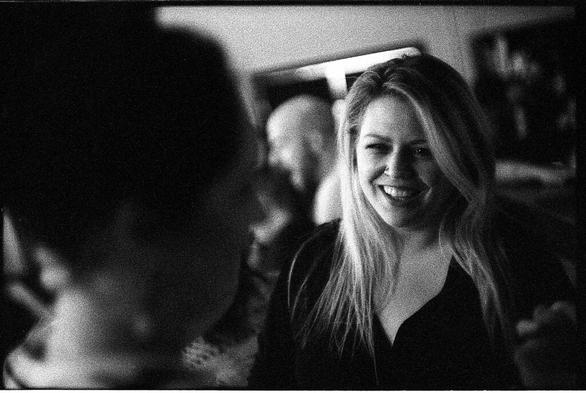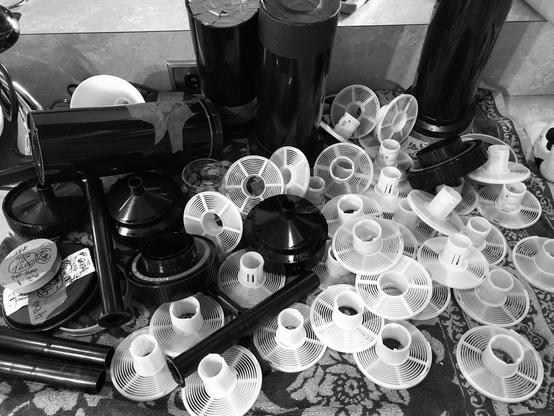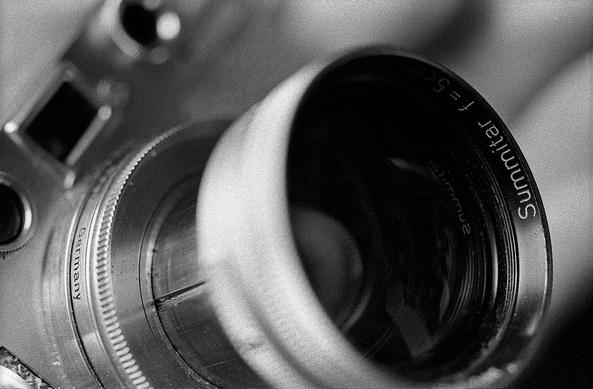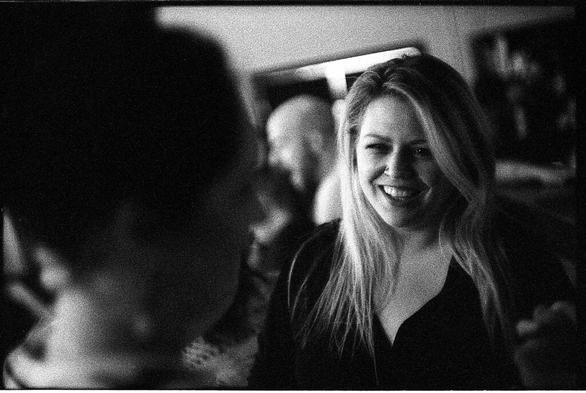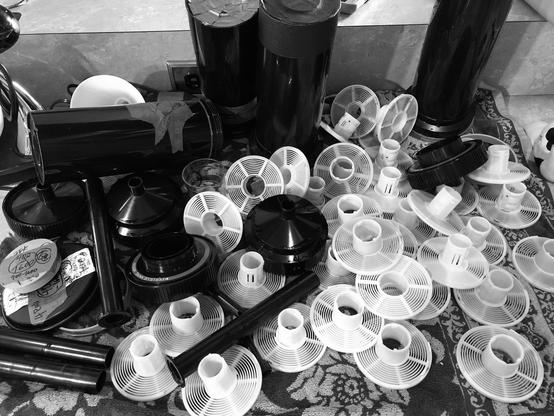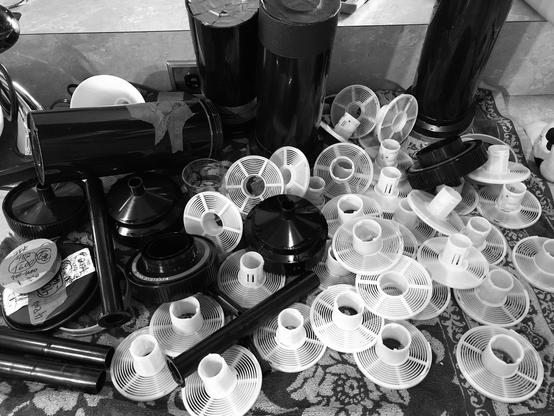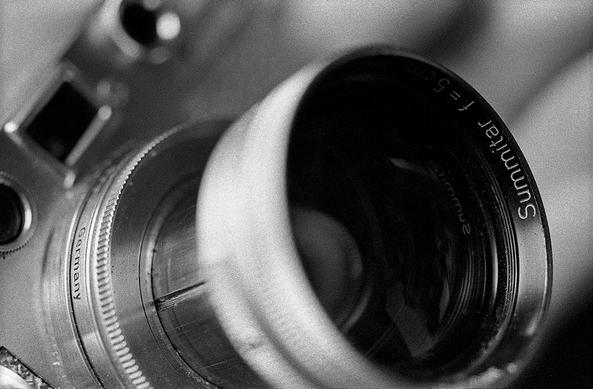Johnny Martyr’s B&W Darkroom Grocery List
If your New Year's resolution is to start processing your own b&w film at home, or you're just interested in comparing notes, I thought it would be handy for me to share my darkroom grocery list.
Disclaimer - I am not a chemist! I'm just a photographer who has found some products and methods that work for my specific purposes. We all have to carve our own path but we can also learn from one another.
My degree is in film, video and theatre. I learned to process in college, from accredited professionals using standard products and practices. As I began working at home, I refined things slightly but have been doing more or less same thing across hundreds of rolls a year intermittently for two decades.
30 rolls of Kodak 36 exposure 35mm from a wedding shoot - a typical workload for me
I shoot Kodak TMAX 100, Fuji Acros 100, Kodak Tri-X 400, Kodak TMAX P3200 and Ilford Delta 3200. I routinely push my Tri-X to EI 1600 and 3200 films to EL 6400. I am primarily a 35mm guy but I sneak in some 120 here and there too. For all these films, I currently use Kodak HC110 Dilution B for its high accutance, accurate push processing, ease of use and economy. The rest of my chemistry is also by Kodak and I'd say I'm pretty Kodak-oriented. If you don't use these films or just don't like the look of my work, then HC110b might not be for you but most of the other products mentioned here have no bearing on the final look of the image. So maybe you can ignore my lack of taste and find something of interest to you anyway!
I heart Kodak
Part of my reason for sticking with Kodak is simply that I have never seen a printed darkroom guide by Fuji, Ilford or any other manufacturer of photochemistry that is as comprehensive and straightforward as the Kodak B&W Darkroom Dataguide. If you found one that I haven't, let me know in the comments! But the Kodak dataguide was a required text book when I was in school and it's still my bible.
The Kodak B&W Darkroom Dataguide Sixth Edition - one of the most important books I've ever read!
I've tried other brands here and there but have always just come back to what I'm comfortable with and has continued to work. I don't believe in buying fifteen different types of film and trying every possible combination of exposing and processing known, or as of yet unknown, to humankind. I believe in consistent and predictable results; accuracy through comfortable, tried and true routines. This allows me to concentrate on the act of taking pictures moreso than the infinitely complex minutia of chemistry.
I am more than happy to dump any mixed chemistry that has any chance of negatively affecting my work. I don't skimp on supplies to save a few bucks while potentially threatening the quality of my negatives. I always mix my developer fresh for each tank and I always test my fixer/examine my chemistry for exhaustion before getting started. You will see some amateur chemists musing about making their own stop bath with vinegar and developing their film using coffee or their ex-girlfriend's piss or whatever. This is all very entertaining and interesting but I work by the Kodak B&W Darkroom Dataguide and I only deviate if I find it absolutely necessary or absolutely inconsequential. I prefer to support Kodak than Folgers. You do what you like.
I process my film in five-reel tanks, so I begin by grouping all my film into clusters of five - these rolls represeent two weddings and some personal work
If you are new to processing, you can process just one or two rolls at a time like most people. However, I strongly suggest that shooters work towards the method I use, or something even more, which is processing two five-reel tanks at the same time (that's ten rolls of 36 exposure 35mm). My reason for doing this is that, like most people, my chemistry is mixed to one gallon jugs and two five-reel Patterson tanks use just under one gallon. This enables one to get the most use of their chemicals and fastest total processing time. So rather than mixing a gallon of Kodak HC110b, a gallon of stop, a gallon of fix, and a gallon of hypo, using only a fraction of it to process two rolls of 35 and then letting everything sit, potentially expiring, bottles leaking, work not getting done, whatever, for however long before processing again, you've done as much work as gallon mixes can afford and, if working accurately, the development across ten rolls of film is consistent. Ten rolls of 35mm will keep you off the streets and busy with the scanning.
About to be squeegeed!
That being said, if I'm doing something unusual, I'll scale back how much film I am processing so as to concentrate on the change and do it correctly without potentially harming other rolls. I also understand that it takes a little bit of courage to process more than two rolls at a time because if you mess up, you lose ALOT of film. Ironically though, another reason that I process ten at a time is so that I can mix three or four projects worth of film together. This ensures that if, for some unlikely reason, I did mess them all up, no single project would be fully destroyed. I find that probably most film shooters' worst detriment is not shooting and processing enough. The more film that I can process in a short span of time, the quicker turnaround times are for clients but also, I'm inclined to shoot more and concentrate on improving my actual photography because each single roll sort of has less mental/emotional weight to it, if that makes sense. So by all means, take your time to work up to ten rolls at once! But I do really recommend aiming high.
Cut and sleeved on the light table
Perhaps another noteworthy quirk of mine is that I fully endorse using a squeegee to dry my negatives. Many shooters will tell you that squeegees are only good for scratching ones film and are at best, simply not necessary. I don't use a squeegee to accelerate drying times, although it does help with that. I use one because if I don't, I get water spots on my images. Because of the numerous conversations I've had with other photographers, I understand that the choice to use a squeegee has as much to do with ones water supply, the air quality of the area where one hangs their film and even ones skin type as it does with subjective personal preference. So I won't preach the squeegee but I will offer it as a solution to seemingly incurable drying artifacts.
Without any further delay, I present to you, my black and white darkroom grocery list!
Kodak B&W Darkroom Dataguide Sixth Edition - This book was last published in 2001, it's important to get this most up-to-date copy though older copies have neat features such as sample printing paper. Prices on the Dataguide rise and fall with the wind. It will have to be purchased from a used book store, Amazon or eBay. And yes, it may take a little time to find an affordable copy. Certainly write to Kodak and recommend that they publish a new edition of this wonderful book!
[Distilled Water](http://Distilled Water - I only use distilled for my final rinse, but some will tell you that you should pre-rinse your film to reduce shock of the developer.) - I use distilled for my final rinse, but some will tell you that you should also pre-rinse your film to reduce shock of the developer. Kodak doesn't recommend it so I've never done it and my film has never complained about feeling shocked! You can also get away with not using distilled to do your final rinse if your water supply is not hard. When I lived in Baltimore, I didn't use distilled, the tap water was great for processing. I didn't even have to squeegee. But when I moved to a nicer area with a private, carefully regulated water supply, where the community is constantly debating if we should have fluoride or not, my negatives were crudded up with mineral deposits. I started rinsing with distilled AND using a squeegee to resolve this. Distilled water also makes for a tasty drink while standing around in my kitchen waiting for the next agitation, though I have to admit, I usually prefer a cold Flying Dog. Oh, and this is important, I use my empty distilled one gallon bottles to dump my spent chemistry in. I tape up the tops and label them so that there's no chance of their contents being mistaken (!) then just hold onto them until the designated hazmat collection days in my town.
Kodak HC110 Developer Concentrate - Shipping liquids can be costly so I usually buy from a retailer as close to me as possible or one that offers free shipping. I live in Maryland so New Jersey's Film Photography Project is my first choice, with New York's B&H and Adorama following. In recent years, B&H has noted on their site that some darkroom chems are considered hazmats and can only be purchased locally at their store. Another choice, if you don't live on the East Coast is FreestylePhoto.biz in California.
Kodak HC110 - the old formula on the left and the current formula on the right
Kodak Stop Bath Concentrate - Some folks use water as a stop bath. However, Kodak does not endorse this and I've read various debates back and forth but for me, using Stop hasn't hurt my negatives and costs very little so I just do what Kodak recommends and has worked for me. Stop is probably my least bought and changed chemical.
Kodak Kodafix Solution - Kodak fixer, charmingly dubbed "Kodafix," is available as both a power that is sold in a sealed mylar envelop and mixes to a gallon, or as a liquid concentrate that is sold in a plastic bottle like the developer and stop. The powder is usually cheaper to purchase and ship. I don't use the powder because I find it slightly more challenging to mix since all the granules need to be fully dissolved, else you risk damage to your film. Dissolving fix isn't difficult but if you use dark bottles to mix your chems in, which you should, then you will need to come up with a method to inspect your solution for undissolved granules before use. Additionally, according to the Kodak B&W Darkroom Dataguide, powder fix should be run for eight minutes whereas liquid fix only runs for four. If you're push processing for 15+ minutes just on the developer, getting four minutes of your life back might be gladly welcomed! The final nail in the coffin for powder is that the mylar envelop cannot be recycled in most areas. All that being said, I burn through fixer only second to developer so if the liquid is not available or I'm short on funds, I'll pick up a couple bags to fill my "emergency" stash. You NEVER want to be all set to process, test your fixer, find you need to replenish and not have another bag or bottle ready to go.
Hypo Check - I get the impression that hypo check is a product that some shooters skimp on. The purpose of it is to check your fixer for exhaustion. While you will likely see that your fixer has turned purple or has been used for X number of rolls and should be refreshed, this is a risky game to play. If your fix is exhausted and you're one of those people, myself included, who relishes in opening your tank, exposing your film to bare light, the moment that the fixer has run its four or eight minute cycle, you could ruin your film. And even if your film doesn't get ruined by light, fixing with exhausted fix results in purple negatives that need to be fixed again until clear. So it's just a waste of time not to use hypo check. I have found no value in different brands of hypo check. Remember, it has no direct effect on your images, it's only to test the fixer. So buy whatever brand is cheapest. I like to buy as large a bottle as I can so it's one less thing to worry about stocking up on for a while.
Wetting Agent - Here's another one where I don't think that brand matters much. However, you will likely stumble across heated debates over brands of wetting agent amongst the very old gatekeepers of film photography. I've used several brands of varying prices and have never observed any practical difference. My personal choice, however is LFN by Edwal instead of Kodak. And this is ONLY because it is sold in a bottle with an eyedropper which allows for precise usage. Rule of thumb is that you do one drop of wetting agent for each roll of film in your tank and then fill the tank with tap water if you're lucky, or in my case, distilled water for that final rinse discussed above. Do not over agitate the wetting agent. You should see some suds form but you don't want to give your film a bubble bath!
LFN wetting agent - one drop per reel of 35mm
Patterson Developing Tank and Reels - The argument rages; metal or plastic? As much as I want to get behind metal tanks and reels, I just can't use them for 35mm. I prefer them for 120 but with 35mm film at 36 exposure lengths, I just cannot reliably load the reels as confidently, reliably and quickly as I can plastic Patterson autoloads. And yes, I have Hewes stainless steel reels, unanimously the best version available. If you practice and can get good at loading metal reels and using metal tanks, I admire you. This saves chemistry, which means you can potentially process more film in a session than me and you own some quality equipment that you'll never have to replace because it likely will never break. If you click on the Patterson tank/reels hyperlink, you can read about why I still prefer Patterson.
Patterson tanks loaded and marked with their contents - I cover them in painters or masking tape both to note what's inside as well as to secure the lids as a reminder that bare, unprocessed film is inside. In case I have to stop working and return later, I don't accidently open a tank or process it incorrectly!
Changing Bag - Buy yourself a large changing bag for processing and keep a small changing bag in your camera bag for emergencies. Changing bags are one of the most important bits of gear that a film photographer can have on hand. If you like, you can even buy a changing tent! No more of this towel under the bathroom door bullshit! Buy the right tools and do things right. Instead of hiding in a windowless bathroom, hoping that I remembered to lock the door and that nobody waltzes in on me, I sit on the couch with my large, spacious changing bag on my lap, loading my reels and watching TV!
Film Canister Opener - Here's another small point of contention for me. So many thrifty film photographers will encourage each other to use a can opener to open their film canisters. I disagree. Can openers aren't QUITE designed to easily open a film canister. But you know what is? A film canister opener! Use the right tool. Support businesses that support film photography. Also, some folks use a film leader retriever so as not to have to open the canister at all. And hey, these can come in handy to keep in your bag anyway.
Squeegee - I like Dot Line squeegees. Each side of the squeegee features three blunt edged rubber blades. There is a basic plastic spring built into the hinge. I find that with age and use the hinge seems to be the first part of the device to fail. I have yet to use one of these long enough that the rubber began to deteriorate. For me, the spring tension is important to my feel for how softly to glide the squeegee over my film. So when it breaks, I replace it, though ostensibly, one could continue using it as is. I buy two at a time because, you know, they don't break while you're not in the middle of something! I have tried the Patterson squeegee but find it more difficult to use correctly. It has sharp edged rubber blades and just two per side, not three like the Dot Line. It's perhaps counterintuitive but I think the thinner sharp blades, despite having less surface area to contact the film, are more likely to scratch than the dull blunt blades of the Dot Line. I don't blame my tools and believe that either can be used properly. But I just prefer the Dot Line. Yankee also makes a "squeegee" that replaces the rubber blades with sponges. We used these in school and I don't recall having any problems with them.
Film Drying Clips - These are a bit of a personal thing and much can be dictated by where you hang your film to dry. Many folks hang their film to dry in a bathroom after running a hot shower to produce humidity which decreases static in the air and dust on your film. I think it also helps counteract curling of the film. Anyway, something like the MOD54 hangers in the above hyperlink would be good for use in that scenario. For me, I have these beautiful floor to ceiling windows in my dining room that I enjoy hanging my film in like a giant lightbox. I can easily hang 20 or more rolls of film at a time in just one window and be able to study their contents at a glance or closer examination if required. My wife kindly tolerates me hanging curtain hooks on the rods to these windows with standard binder clips or vintage stainless steel film clips by Kodak, Pako etc., attached to my film.
Photography is a family activity in our house! We hang my processed film in our dining room floor-to-ceiling windows to dry.
Five One Gallon Bottles - You need one for developer, one for stop, one for fix, one for hypo and one as a spare for when something tragic inevitably happens to one of the bottles or lids while you're in the middle of processing. The same people who cover the logos on their Leica's with black electrical tape will swear by using their grandmother's antique amber glass bottles plugged by corks from the local vineyard in which to keep their chemistry. And while I appreciate glass and aesthetic as much as the next anachronist, I prefer brand new (well, now they're getting kinda old) brown plastic darkroom bottles by Delta. They are cheap, light weight and aren't easily broken. Some folks also use "accordion" plastic bottles, which seem like a smart idea to me. The idea is that you collapse the bottle as you spend the chemistry so as to minimize oxidation. My thing is that the chems that I reuse stay pretty close to the top of my bottles and the chems that I don't reuse, I use the full bottle. To me, this is one of those extra steps that one takes as compensation for not shooting/processing more and trying to be cost-efficient.
Thermometer - I really can't stand the old Kodak mercury style thermometers. The refraction of the glass can be difficult to read through at some angles and they can sink into a deep beaker etc. I REALLY like the Weston stainless steal circular or "dial" thermometer that came to me from a friend's dad's old pro darkroom. They're a little pricey but they're quite nice and there are cheaper models available. They feature a clip underneath the dial that can move up and down the sensor part of the thermometer. This allows you to mount the thermometer at any height you want within a liquid. Also, I tend to think that for beakers, you are getting a more accurate reading across the height of the liquid due to the sensor being comprised of a long stem as oppose to the bottom of a conventional mercury type thermometer. I've never needed to do this, but they can also be manually recalibrated which is pretty neat. Oh and of course, it takes no batteries like a modern thermometer. And I know how film guys hate batteries. But finally, the Weston is just easy to read. Larger dial faces are even available.
68 is the magic number!
Graduates - Over time, you wind up just collecting graduates of various sizes and types. The most indispensable for me is a 42oz plastic beaker that I mix developer with. It takes three of these filled with water, plus 4oz of HC110 concentrate to make one gallon of HC110b solution. I have some vintage 32oz glass and plastic Kodak brand graduates just for getting water to the right temp and mixing other chems. Because I'm pretty well set on HC110b, I also picked up a cute little 4oz Kodak glass that is as dedicated as I am to HC110.
I love these old glass Kodak graduates! It's important not to mix up your chemistry!
Funnel - Funnels are essential to pouring from graduates into your one gallon bottles. They don't need to be fancy.
Sleeves - There are many choices. I have never had any issues with Print File brand sleeves in the 20 years I've been processing. The very first negatives that I processed back in school looked and smelled lovely last I checked. As do the Print File sleeves. Because I only shoot 36 exposure rolls of 35mm and still use a flatbed scanner, I buy 35-7 sleeves, that's 7 rows of 6 frames each. Because each row accommodates 6 frames, there are no binder holes as many shooter might prefer for storage of their sleeves. I just keep my finished sleeves boxed. If this offends your sense of order, you might have to sacrifice the 6 maximum frames you can put in each side of an Epson flatbed scanner to just 5 frames. But maybe you're one of those super hip film photogs who uses a digital cam to "scan."
Tools of the trade Light table shots of the negs for my Leica M6 TTL blog
So there are some other odds and ends that are needed to process but you'll figure those out as you go along as everyone does.
I know it's been wordy but hopefully this will be a useful reference to review or get started with. Let me know if I forgot anything and please, by all means, challenge my decisions and give me your recommendations! Developing is always developing! Ha!
Thanks for reading, happy shooting (and processing!)
_Follow, Favorite, Like, Add, Insult, ContactJohnny Martyr _
#filmphotography #kodak #martyrmusings #reviews #tipstricksadvice #100 #1600 #3200 #32oz #35mm #35mmfilm #35mmfilmdeveloping #35mmfilmprocessing #35mmphotography #400 #4oz #6400 #adorama #bh #bw #beaker #binderclips #blackandwhite #blackandwhitefilm #blackandwhitefilmphotography #changingbag #concentrate #darkroom #developer #developing #developingbwfilm #developingblackandwhitefilm #distilledwater #dotline #edwal #film #filmcanister #filmcanisteropener #filmdeveloping #filmdryingclips #filmphotographer #filmphotographyproject #filmprocessing #filmweddingphotographer #fixer #flyingdog #freestylephoto #fujiacros100 #funnel #getstarted #glassbeaker #graduate #hazmat #hc110 #hewesreels #hypo #hypocheck #ilforddelta3200 #kitchen #kodafix #kodakbwdarkroomdataguide #kodakhc110 #kodakhc110b #kodakprofessional #kodaktmax100 #kodaktmaxp3200 #kodaktrix400 #leica #lfn #onegallonbottle #pattersonfilm #pattersonreels #pattersontanks #photoflo #plasticbeaker #practices #processing #processingbwfilm #processingblackandwhitefilm #products #recommendations #refer #reference #rinse #share #sleeves #solution #squeegee #stop #stopbath #tape #thermometer #weddingphotographer #weddingphotography #weddings #weston #wettingagent #yankee
